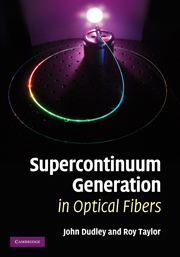Book contents
- Frontmatter
- Contents
- List of contributors
- Preface
- 1 Introduction and history
- 2 Supercontinuum generation in microstructure fibers – a historical note
- 3 Nonlinear fibre optics overview
- 4 Fibre supercontinuum generation overview
- 5 Silica fibres for supercontinuum generation
- 6 Supercontinuum generation and nonlinearity in soft glass fibres
- 7 Increasing the blue-shift of a picosecond pumped supercontinuum
- 8 Continuous wave supercontinuum generation
- 9 Theory of supercontinuum and interaction of solitons with dispersive waves
- 10 Interaction of four-wave mixing and stimulated Raman scattering in optical fibers
- 11 Nonlinear optics in emerging waveguides: revised fundamentals and implications
- 12 Supercontinuum generation in dispersion-varying fibers
- 13 Supercontinuum generation in chalcogenide glass waveguides
- 14 Supercontinuum generation for carrier-envelope phase stabilization of mode-locked lasers
- 15 Biophotonics applications of supercontinuum generation
- 16 Fiber sources of tailored supercontinuum in nonlinear microspectroscopy and imaging
- Index
16 - Fiber sources of tailored supercontinuum in nonlinear microspectroscopy and imaging
Published online by Cambridge University Press: 06 July 2010
- Frontmatter
- Contents
- List of contributors
- Preface
- 1 Introduction and history
- 2 Supercontinuum generation in microstructure fibers – a historical note
- 3 Nonlinear fibre optics overview
- 4 Fibre supercontinuum generation overview
- 5 Silica fibres for supercontinuum generation
- 6 Supercontinuum generation and nonlinearity in soft glass fibres
- 7 Increasing the blue-shift of a picosecond pumped supercontinuum
- 8 Continuous wave supercontinuum generation
- 9 Theory of supercontinuum and interaction of solitons with dispersive waves
- 10 Interaction of four-wave mixing and stimulated Raman scattering in optical fibers
- 11 Nonlinear optics in emerging waveguides: revised fundamentals and implications
- 12 Supercontinuum generation in dispersion-varying fibers
- 13 Supercontinuum generation in chalcogenide glass waveguides
- 14 Supercontinuum generation for carrier-envelope phase stabilization of mode-locked lasers
- 15 Biophotonics applications of supercontinuum generation
- 16 Fiber sources of tailored supercontinuum in nonlinear microspectroscopy and imaging
- Index
Summary
Introduction
Over the past few years, new optical fibers with enhanced nonlinearity and tailored dispersion (Russell 2003; Knight 2003) have been providing a constantly growing platform for the development of advanced fiber-format devices and components for optical metrology (Jones et al. 2000; Udem et al. 2002), ultrashort-pulse laser technologies (Zheltikov 2007a), biomedicine (Hartl et al. 2001), quantum optics (Rarity et al. 2005), spectroscopy (Sidorov-Biryukov et al. 2006), and microscopy (Paulsen et al. 2003). Unique options offered by photonic-crystal fiber (PCF) technology (Russell 2006), such as dispersion management through fiber structure engineering (Reeves et al. 2003) and enhancement of optical nonlinearity due to a strong field confinement in a small-size fiber core (Fedotov et al. 2001), have been pushing the frontiers of fiber optics, allowing the creation of efficient sources of supercontinuum radiation (Ranka et al. 2000; Dudley et al. 2006; Zheltikov 2006), novel compact fiber lasers (Lim et al. 2002; Limpert et al. 2006), as well as frequency converters (Akimov et al. 2003), pulse compressors (Südmeyer et al. 2003), fiber components for biomedical optics (Flusberg et al. 2005a, 2005b), and optical sensors (Monro et al. 2001).
In the rapidly expanding field of nonlinear microscopy and spectroscopy, PCFs have been shown to possess a tremendous potential for making laser microscopes and spectrometers simpler and much more compact through the replacement of wavelength-tunable laser sources, such as optical parametric amplifiers and dye lasers, by a specifically designed segment of fiber.
Information
- Type
- Chapter
- Information
- Supercontinuum Generation in Optical Fibers , pp. 373 - 398Publisher: Cambridge University PressPrint publication year: 2010
